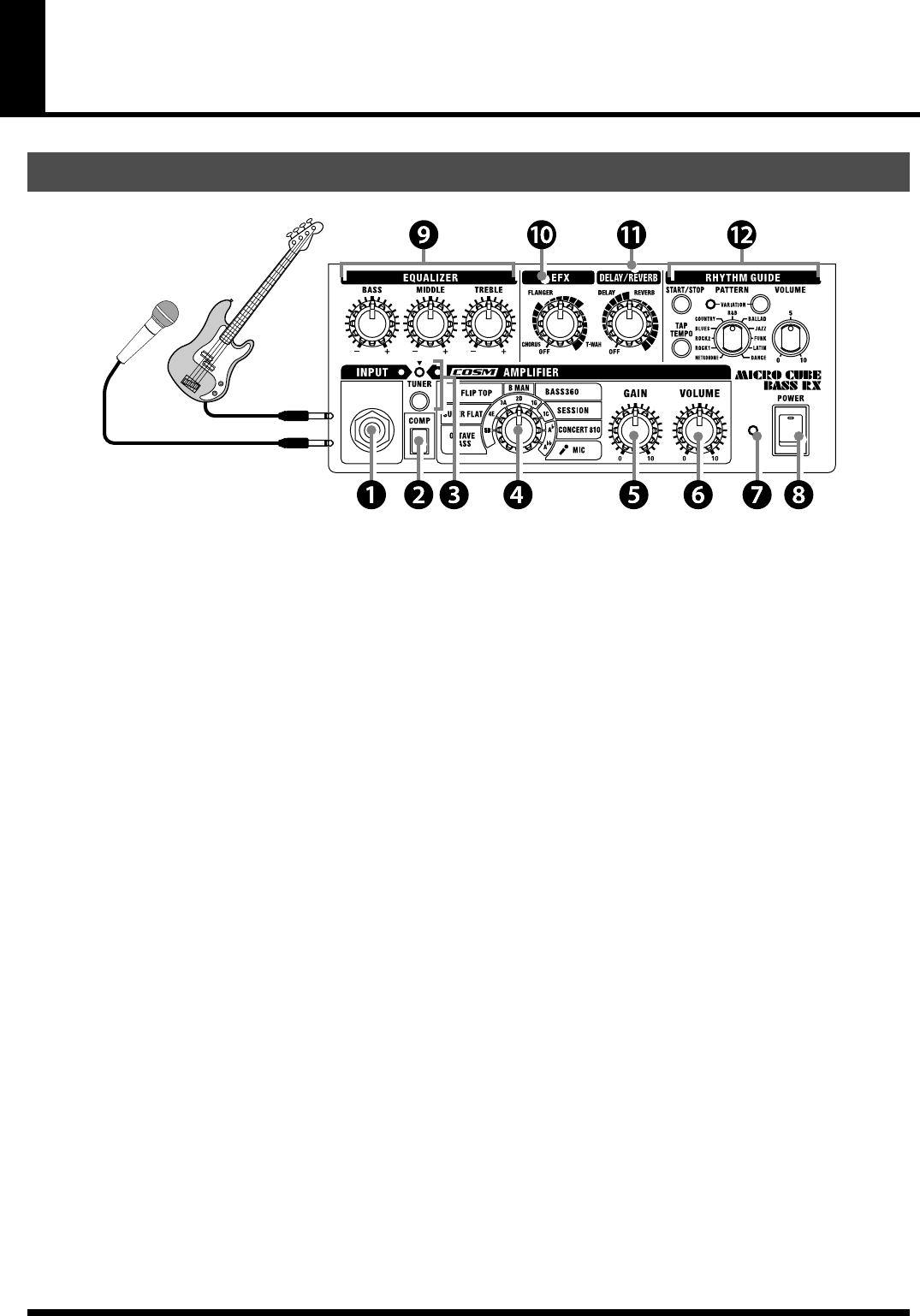
6
Panel Descriptions
fig.01-01
1. INPUT Jack
Connect your bass guitar or microphone here.
2. COMP (COMPRESSOR) Button
Pressing the COMP button switches on the COMPRESSOR function.
This allows you to compress high level signals without distorting
the original sound. It also suppresses the attack portions and delivers
a smooth, consistent sound.
3. TUNER
The tuner function supports six-string bass tunings.
In addition to manual tuning, in which strings are specified, you can
also use it as a chromatic tuner.
→ Using the Tuner Function (p. 9)
4. AMP TYPE Knob
You can select from eight COSM amp types. When the TUNER
function is on, you can specify a string (note name).
* The product names mentioned in this document are trademarks
or registered trademarks of their respective owners, and are not
related to Roland Corporation. In this manual, these names are
used because it is the most practical way of describing the sounds
that are simulated using COSM technology.
OCTAVE BASS
This original amp type creates sounds one octave below the input
sounds and layers them together to create a fatter bass sound.
* This function does not work properly when playing chords.
Mute the other strings and play a single note.
SUPER FLAT
An original amp featuring a wide-range frequency response.
This amp type provides faithful reproduction of the connected bass's
own sound. This is a great type for all kinds of connected instruments.
It is ideal for reproduction of an electric upright bass.
FLIP TOP
Models the Ampeg B-15 (1 x 15"). This amp provided the
underpinning for many of the most famous Motown hits.
It features a fat sound, while the amp's compact cabinet produces
a distinct contour.
B MAN
Models the Fender Bassman 100 (4 x 12"). This amp has been
a favorite since the inception of electric basses.
It features the sonic characteristics of tube amps, whereby increasing
the distortion yields a slightly fatter sound.
BASS 360
Models the acoustic 360 (1 x 18"). This amp was used in the '70s not
only by famous jazz bassists, but by funk and hard rock players as well.
It is characterized by a warm low end, and a contoured midrange.
SESSION
Models the SWR SM-400 + Goliath (4 x 10") + Big Ben (1 x 18").
This tweeter-equipped amp is representative of the "L.A. Sound" that
emerged in the '80s. It features a wide-range tone that balances
presence in the low end with a clear, open sound.
CONCERT 810
Models the Ampeg SVT + 810E (8 x 10"). This amp typifies the rock
sound that relied heavily on combinations of high-output, tube amp
sections and large-sized cabinets. The characteristic sound is one
of overwhelming low-frequency sound pressure.
MIC
Select this when a microphone is connected.
* Please note the following points when using a microphone.
• Feedback could be produced depending on the location of
microphones relative to the unit. This can be remedied by:
1. Changing the orientation of the microphone(s).
2. Relocating microphone(s) at a greater distance
from the unit.
3. Lowering volume levels.
• The sound will be distorted if you turn the GAIN knob up
too high. Set the GAIN knob to as high a value as possible
before the sound distorts to get the best signal-to-noise ratio.
• Use a dynamic microphone.
You cannot use a condenser microphone or a plug-in
powered microphone that requires a power supply.
Control Panel
Bass Guitar
Dynamic Mic
Standard
Mono Cable
MCB-RX_r_e.book Page 6 Thursday, January 10, 2008 1:00 PM


















